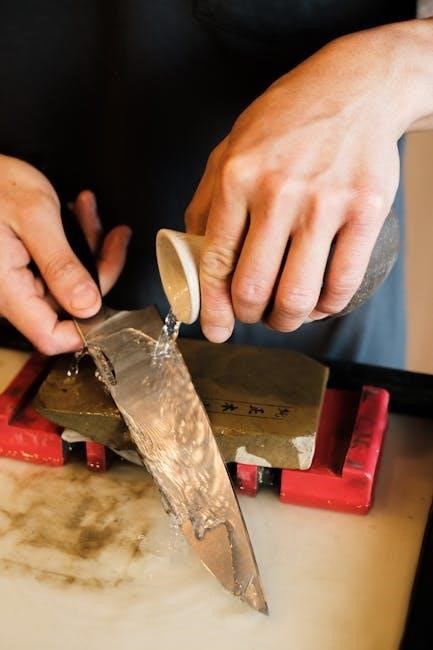A sharpening stone angle guide is essential for achieving precise blade sharpening. It ensures accuracy and consistency, helping maintain optimal edge durability through proper angle selection.
Understanding Sharpening Stone Angle Guides
A sharpening stone angle guide is a tool that helps maintain the correct angle when sharpening a knife on a stone. It ensures consistency and accuracy, enhancing the sharpening process and preventing uneven edges.
2.1 What is a Sharpening Stone Angle Guide?
A sharpening stone angle guide is a tool designed to help maintain the correct angle when sharpening a knife on a whetstone. It ensures consistency and accuracy, preventing uneven edges. This simple device typically attaches to the knife or the sharpening stone, guiding the blade at the desired angle. By providing a stable reference point, it simplifies the sharpening process, especially for beginners. The guide allows users to replicate the same angle consistently, which is crucial for achieving a sharp, durable edge. Different types of angle guides are available, ranging from basic metal or plastic attachments to more advanced adjustable models. These tools cater to various sharpening needs, ensuring that both novice and experienced users can achieve professional-grade results. Ultimately, a sharpening stone angle guide enhances the efficiency and effectiveness of knife sharpening, making it an indispensable accessory for anyone looking to master the craft.
2.2 Importance of Using an Angle Guide
Using a sharpening stone angle guide is crucial for achieving consistent and precise results when sharpening a knife. It helps maintain the correct angle throughout the process, ensuring an even edge and preventing uneven wear. Without an angle guide, it’s easy to deviate from the optimal sharpening angle, leading to a dull or damaged blade. The guide minimizes human error, making it especially beneficial for beginners who may struggle to maintain the correct angle manually. Proper angle maintenance enhances the knife’s cutting performance and durability. Additionally, using an angle guide saves time by streamlining the sharpening process and reducing the need for frequent adjustments. It also helps extend the knife’s lifespan by avoiding over-sharpening or creating uneven edges. Ultimately, an angle guide is an essential tool for anyone aiming to master knife sharpening, ensuring consistent, professional-quality results with minimal effort. Its importance lies in its ability to simplify and refine the sharpening experience.
2.3 Types of Angle Guides Available
Several types of angle guides are available to cater to different sharpening needs. Magnetic angle guides are popular for their ease of use and ability to attach securely to the sharpening stone. Adjustable angle guides offer flexibility, allowing users to set specific angles for various knife types. Fixed angle guides are ideal for beginners, providing preset angles that simplify the sharpening process. Additionally, digital angle guides use technology to precisely measure and maintain the angle, offering high accuracy for advanced users. Each type has its own benefits, making it important to choose one that aligns with the user’s skill level and sharpening goals. By selecting the right angle guide, users can optimize their sharpening results and ensure consistent blade performance. The variety of options ensures that both novices and experts can find a tool that meets their specific requirements, enhancing the overall sharpening experience.
2.4 Factors Influencing the Sharpening Angle
The sharpening angle is influenced by several factors, including the knife’s intended use, blade type, and desired edge durability. For instance, knives used for chopping or heavy-duty tasks typically require a larger angle, such as 30° to 40°, to enhance durability and withstand rough usage. In contrast, knives for slicing or precision work benefit from a smaller angle, around 20° to 30°, to achieve a sharper, more refined edge. The blade’s steel type also plays a role, as harder steels may require more precise angles to avoid chipping. Additionally, the user’s skill level and the sharpening tool being used can impact the chosen angle. Maintaining consistency in the angle ensures even wear and optimal performance of the blade. Understanding these factors is crucial for selecting the right angle guide and achieving the best sharpening results. Proper alignment and technique are essential to maximize the knife’s functionality and longevity.

Choosing the Right Sharpening Angle
Choosing the right sharpening angle depends on the knife’s type, intended use, and desired sharpness. Common angles range from 20° for precision cutting to 30° for general-purpose knives. Understanding blade geometry and user needs ensures optimal results.
3.1 Common Sharpening Angles for Different Knives
Different knives require specific sharpening angles to optimize their performance. Chef knives typically use a 20° angle for precision cutting, while serrated knives often require a slightly narrower angle, around 15°, to maintain their unique edge. Hunting knives benefit from a steeper angle, usually between 25° and 30°, to ensure durability and strength for heavy use. Straight razors, designed for shaving, are sharpened at a very acute angle of 10° to 15° for extreme sharpness. Conversely, axes and chopping tools may use a much wider angle, around 35°, to withstand rough cutting tasks. Understanding these common angles helps users achieve the best results for their specific tools, ensuring both sharpness and longevity of the blade.
3.2 How Blade Type Affects the Sharpening Angle
The type of blade significantly influences the sharpening angle, as different designs require specific edge geometries. Straight-edged knives, like chef knives, typically use angles between 20° and 30° for balanced sharpness and durability. Serrated knives, however, often require a narrower angle to maintain their serrated edges effectively. Curved blades, such as those on fillet knives, may need a slightly variable angle to accommodate their shape; The blade’s intended use also plays a role; for example, a knife for chopping requires a steeper angle for strength, while a slicing knife benefits from a shallower angle for precision. Additionally, the blade’s bevel type (e.g., convex, concave, or flat) can dictate the optimal angle. Blade thickness and hardness further influence the angle, as thicker or harder blades may need wider angles for durability. Understanding these factors ensures the sharpening process aligns with the blade’s design and purpose, maximizing its performance.
3.3 Impact of Sharpening Angle on Edge Durability
The sharpening angle has a direct impact on the durability of a knife’s edge. A smaller angle produces a sharper edge but may result in a more fragile blade, prone to chipping or wear. Conversely, a larger angle creates a stronger, more durable edge, though it may not be as sharp. The optimal angle balances sharpness and durability, depending on the knife’s intended use. For instance, knives used for heavy-duty tasks benefit from wider angles (e.g., 30° to 40°), as this enhances edge retention and resistance to damage. In contrast, knives requiring precision, like straight razors, often use narrower angles (e.g., 15° to 20°) for keenness, sacrificing some durability. The blade’s hardness also plays a role; harder steel can withstand narrower angles without deforming, while softer steel may require wider angles to maintain structural integrity. Choosing the correct angle ensures the edge remains functional and resilient over time. Proper angle selection is crucial for maximizing both performance and longevity.

Using a Sharpening Stone Angle Guide
A sharpening stone angle guide ensures precise control over the sharpening process, helping maintain consistent angles for optimal edge sharpness and durability. It simplifies the technique, making it accessible for both beginners and experts.
4.1 Steps to Use an Angle Guide Effectively
Using a sharpening stone angle guide requires careful preparation and consistent technique to achieve the best results. Start by setting the desired angle on the guide, ensuring it aligns with the knife’s edge. Position the knife on the stone, placing the guide alongside the blade to maintain the selected angle. Hold the knife firmly but gently, with the bevel flat against the stone. Slowly draw the knife across the stone in smooth, even strokes, applying light to moderate pressure. Repeat this process on both sides of the blade, flipping the knife when necessary. Use the guide to check and adjust the angle as needed, ensuring consistency. After sharpening, inspect the edge for sharpness and clean the stone thoroughly. Regular practice will enhance your ability to use the guide effectively, leading to sharper, more durable knife edges.
4.2 Setting the Correct Angle

Setting the correct angle when using a sharpening stone angle guide is crucial for achieving a sharp and durable edge. Begin by identifying the recommended angle for your knife, typically between 15° and 30°, depending on the blade type and intended use. Hold the knife at this angle and position the guide alongside the edge to ensure alignment. Adjust the guide until it matches the desired angle, securing it firmly in place. Once set, maintain this angle throughout the sharpening process by keeping the guide steady. For consistency, periodically check the angle against the guide, especially when switching sides or adjusting pressure. Proper angle alignment ensures even wear on the stone and a precise edge on the blade. Always refer to the manufacturer’s guidelines for specific angle recommendations tailored to your knife type and sharpening goals.
4.3 Maintaining Consistency While Sharpening
Maintaining consistency while sharpening is essential for achieving a precise and even edge. Use the angle guide to keep the sharpening angle steady throughout the process. Apply consistent pressure to avoid uneven wear on the stone and blade. Regularly inspect the edge to ensure uniform sharpening. Repeat strokes evenly on both sides of the blade to maintain balance. This consistency ensures a sharp and durable edge, crucial for optimal performance. Additionally, maintaining a consistent sharpening pattern helps prevent over-sharpening, which can weaken the blade. By following these steps, you can achieve professional-level sharpening results with ease and reliability, ensuring your tools remain in top condition for longer.

4.4 Troubleshooting Common Issues
When using a sharpening stone angle guide, common issues may arise that affect the sharpening process. One frequent problem is the blade slipping out of the guide, which can lead to inconsistent angles. To resolve this, ensure the guide is securely attached to the stone and the blade is properly aligned. Another issue is uneven sharpening, often caused by inconsistent pressure or strokes. To fix this, maintain steady, controlled movements and check the edge regularly. If the guide feels unstable, verify that the sharpening stone is flat and properly secured. Additionally, if the desired sharpness isn’t achieved, it may be due to incorrect angle settings or using the wrong grit stone. Adjust the angle according to the blade type and progressively use finer grits for better results. Addressing these issues promptly ensures efficient and effective sharpening.

Advanced Sharpening Techniques
Mastering advanced sharpening techniques enhances precision and efficiency. Learn precision sharpening, adapt to different steel types, and integrate angle guides with other tools for superior edge craftsmanship and durability.
5.1 Precision Sharpening with an Angle Guide
Precision sharpening with an angle guide ensures consistent and accurate edge formation. By maintaining the optimal angle, you can achieve a sharper, more durable blade. This method minimizes errors, making it ideal for novice and experienced sharpeners alike.
- Use the guide to set the desired angle accurately, ensuring uniform strokes across the sharpening stone.
- Focus on light, controlled pressure to avoid over-sharpening or creating uneven edges.
- Practice adjusting the angle based on the blade type, as different steels and knife styles require specific configurations.
- Regularly inspect the edge to monitor progress, ensuring the desired sharpness is achieved without over-polishing.
With patience and practice, precision sharpening becomes second nature, delivering professional-grade results every time.
5.2 Sharpening Different Types of Steel
Sharpening different types of steel requires adjusting your technique and angle guide settings to accommodate variations in hardness, alloy composition, and edge retention. Softer steels, like those in utility knives, benefit from a slightly wider angle (25-30 degrees) to create a more robust edge. Harder, high-carbon steels, commonly found in premium knives, perform best at narrower angles (20-25 degrees) to maximize sharpness and durability.
- Stainless steel blades: Use a medium angle (22-28 degrees) for a balance between sharpness and resistance to corrosion.
- Carbon steel blades: Opt for a narrower angle (20-25 degrees) to achieve a razor-sharp edge.
- High-carbon stainless steel: Combine the benefits of both, using angles between 20-27 degrees for versatility.
Understanding the steel type ensures you tailor your sharpening approach, resulting in a more effective and long-lasting edge. Always research the specific steel used in your blade for optimal results.
5.3 Combining Angle Guides with Other Tools
Combining a sharpening stone angle guide with other tools can enhance your sharpening process and improve results. For instance, using an angle guide alongside a sharpening steel or diamond stone ensures consistency and precision. Start with coarse tools to remove metal and establish the edge, then refine with finer grits using the angle guide for precise control.
- Sharpening steels: Use the angle guide to maintain the correct angle while honing the blade on a steel.
- Diamond stones: Pair the angle guide with diamond stones for aggressive sharpening while maintaining accuracy.
- Honing rods: Combine the angle guide with a honing rod for quick touch-ups and edge alignment.
By integrating an angle guide with these tools, you can achieve a sharper, more durable edge. This multi-tool approach ensures efficiency and consistency, making it ideal for both beginners and experienced sharpeners. Mastering this combination will elevate your sharpening skills and extend the life of your blades.

Maintaining Your Sharpening Stone
Regular maintenance ensures your sharpening stone remains effective and extends its lifespan. Clean it after use, dry thoroughly, and store in a dry place to prevent damage. Periodically flatten the stone for even sharpening performance.

- Remove metal particles and debris after each use.
- Store in a protective case to avoid chipping or cracking.
- Flatten the stone when it becomes uneven or worn.
Proper care ensures consistent sharpening results and maintains the stone’s quality over time.
6.1 Cleaning and Sanitizing the Stone
Cleaning and sanitizing your sharpening stone is essential to maintain its effectiveness and prevent contamination. Start by removing any metal particles or debris using a soft brush or a damp cloth. For water stones, rinse thoroughly under running water to flush out residue. Oil stones may require a gentle cleaning solution, such as a mixture of water and dish soap, to break down oil and metal shavings. Avoid harsh chemicals, as they can damage the stone. After cleaning, sanitize the stone by soaking it in a 50/50 solution of water and white vinegar for about 10 minutes. This step helps eliminate bacteria and odors. Allow the stone to air dry completely before storing it. Regular cleaning and sanitizing ensure optimal performance and extend the stone’s lifespan. Consistent maintenance also prevents the buildup of unwanted substances that could affect sharpening results. Keep your sharpening stone in pristine condition with these simple care steps.
6.2 Storing the Sharpening Stone Properly
Proper storage of your sharpening stone is crucial to maintain its quality and longevity. After cleaning and drying, store the stone in a cool, dry place away from direct sunlight, which can cause warping or cracking. Use a protective case or wrap it in a dry cloth to prevent dust accumulation and accidental damage. For water stones, ensure they are completely dry before storage to avoid mold or mildew growth. Oil stones can be stored as they are, but wiping off excess oil with a clean cloth beforehand is recommended. Avoid stacking heavy objects on top of the stone, as this could cause breakage. If storing for an extended period, consider placing the stone in a sealed container to protect it from humidity. Proper storage ensures your sharpening stone remains ready for use and maintains its sharpening efficiency. By following these steps, you can preserve the stone’s condition and extend its useful life.
6.3 Flattening the Sharpening Stone
Flattening a sharpening stone is essential to ensure even sharpening and maintain its effectiveness. Over time, the stone may become uneven due to use, which can lead to inconsistent results. To flatten the stone, start by placing it on a firm, flat surface. Use a coarse-grit sandpaper (such as 120-200 grit) and rub it back and forth across the stone’s surface, focusing on high spots. Check the stone regularly to ensure even wear. Once the surface is flat, switch to finer grit sandpaper to polish it. Alternatively, a diamond stone or flattening steel can be used for quicker results. After flattening, clean the stone thoroughly to remove any abrasive particles. Regular flattening ensures your sharpening stone remains effective and delivers precise results. This simple maintenance step is crucial for achieving and maintaining sharp edges on your tools and knives.
Safety Tips
Always handle sharp objects with care, wear protective gloves, and maintain focus while sharpening. Ensure a stable work surface and keep children away to avoid accidents. Safety first!

7.1 Handling Sharp Objects Safely
When using a sharpening stone angle guide, it’s crucial to handle sharp objects with extreme caution. Always wear protective gloves to prevent cuts and ensure a firm grip on the knife. Maintain focus during the sharpening process to avoid accidental slips. Keep children and pets away from the workspace to minimize risks. Ensure the work surface is stable and well-lit to enhance visibility. Never touch the sharp edge of the blade unnecessarily, and store knives securely when not in use. A clean and organized workspace can also reduce the likelihood of accidents. Additionally, consider using a sharpening stone with a non-slip base to maintain stability during the process. By adhering to these safety practices, you can minimize the risks associated with handling sharp objects while sharpening.
7.2 Protective Gear for Sharpening

Using appropriate protective gear is essential when sharpening with a sharpening stone angle guide. Always wear high-quality gloves, preferably made of durable materials like leather or synthetic compounds, to protect your hands from accidental cuts and abrasions. Safety glasses or goggles are equally important to shield your eyes from flying metal particles or debris. Consider using glasses with anti-fog coating for clear visibility. Additionally, a long-sleeved shirt and an apron can protect your skin and clothing from potential sparks or shavings. Ensure all gear fits comfortably to maintain dexterity and focus during the sharpening process. Proper protective equipment not only enhances safety but also boosts confidence, allowing for more precise and effective sharpening. By prioritizing these safety measures, you can enjoy a hazard-free experience while using your sharpening stone angle guide.
7.3 Creating a Safe Sharpening Environment
Creating a safe sharpening environment is crucial for effective and accident-free use of a sharpening stone angle guide. Start by ensuring good lighting in your workspace to clearly see the blade and stone; Use a sturdy, flat surface that won’t wobble or shift during sharpening. Keep the area clean and free from clutter to avoid distractions or hazards. Proper ventilation is also important, as sharpening can generate dust and particles. A fire extinguisher should be nearby, and a first aid kit should be within easy reach. Store sharpening tools securely when not in use to prevent accidental access, especially by children. Supervise others, particularly children, when they are near the sharpening area. Regularly inspect your tools and workspace for wear or damage to maintain safety standards. By organizing and preparing your environment thoughtfully, you can minimize risks and ensure a safe sharpening experience with your angle guide.